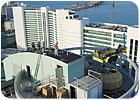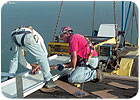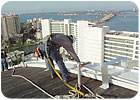
On high-rise structures, roll-forming machines can be elevated by a crane and brought to the to the side of a rooftop to shoot panels directly onto the roof. (Photos courtesy of Englert Inc.)
Roofing contractors who want to become more active in the metal roofing business and have been thinking about pursuing the portable roll-forming route have to ask themselves some questions. First of all, is it worth it?
If you’re already installing standing seam, your customers will tell you it is. Architects, construction project managers and general contractors concerned about budget, scheduling and quality control are routinely concerned about deviations from the contract documents and whether they have to advise the owner when the schedule starts to slip.
One of the easiest ways to avoid any of these issues when the roof designed is metal is to have the roofing material roll formed and installed on the job site. Fabrication of long sheet lengths on the site by roll forming at either ground, eaves or roof level can dramatically speed installation and overcome problems of delivery and access. This on-site capability also means that spans of 120 meters or more can be achieved with no end laps.

The material being run off at the rooftop is from a portable roll that has been out in the field for more than a decade.
Conditions at the Site
Jobsite conditions are another reason why many architects and contractors like working with on-site roll formers to install metal roofing. It is very common to share a worksite with several contractors and subcontractors with vehicles, labor and building materials all working simultaneously on a single jobsite. Often, there is little or no room for equipment and/or materials to be stored before and during a job. Factory-supplied materials must be stored and carted from the storage site over to the building, requiring workers to carry out the material and set it up on the roof. Moreover, factory-manufactured panels have to be lifted to the men on the roof by crews on the ground.Portable roll forming allows the architect and the contractor to control the quality of the product being installed and to complete the work quickly. On-site roll forming also eliminates storage requirements, including forklifts and heavy equipment necessary to unload and factory-supplied materials. It also eliminates concerns about bad weather affecting storage and mobility onsite.
With a roll former you can position the machine where the work needs to be done and run the panels to the lengths the job requires. On high-rise structures you can "crane" the roll-forming machine in the air, abut the machine to the side of a rooftop and shoot panels onto the roof, resulting in major savings in time and labor. Panels can be radiused right on the roof and curved with the use of a curving machine. On some projects, practical restrictions on panel length may necessitate production of panels at the jobsite.
Architects and contractors may also want to weigh the advantages of panel systems that have been designed to be roll-formed on site in terms of ease of delivery and transportation cost advantages. And manufacturing and installing on site can bring other time and labor savings as well.
For example, architects working with the Washington Metropolitan Area Transit Authority (Metro) in the District of Columbia faced an interesting scenario when they designed and supervised the installation of the roof on a totally new train stop inserted between two older existing stations.
The transit system and its designers chose roll-formed material for a second reason. Because the design called for some of the curved roofing panels to be 70 feet long and more, shipping in factory-manufactured panel to the job site on oversized load trucks could have caused project delays. Since Sept. 11, 2001, Washington, D.C., requires trucks with oversized loads to apply for special permits. The transit system saved time and labor using roll-formed materials that could be sized and curved on the site.
Because designers have their own theories on how flashing should be done, having the installation contractor on-site with a roll-forming machine can be a real help in achieving those goals. And it can be very useful if construction plans have evolved and contractors find the plans they are working with are not the same plans originally drawn by the architect. It’s then, more than ever, that architects and general contractors want a roofing contractor on site with a portable roll former that can cut and install the material in real time.

In curved sections, panels can be radiused right on the roof and curved with the use of a curving machine.
Cost Considerations
The second key question is whether or not you can afford to get involved in portable roll forming. After all, it does require some form of capital investment.First off, no one is asking you to jump into the commitment feet first. There are a number of ways you can do it. If you’re already doing standing seam, figure out which panel profile you’re installing the most. If the amount is worth the payback, investigate the cost of buying a new or used machine that runs that panel. We know plenty of roofing contractors who have won the contract for hundreds of squares of standing seam and financed their machine investment from a single project.
Federal tax incentives can help you out as well. Typically, if your machine has a useful life of more than one year, the cost must be spread across several tax years as depreciation with a portion of the cost deducted each year.
But there is a way to immediately receive these income tax benefits in one tax year. The provisions of Internal Revenue Code Section 179 allow a sole proprietor, partnership or corporation to fully expense a roll-forming machine in the year it is purchased.
This option makes it very appealing by dramatically increasing the amount that can be written off immediately. Tax changes first made in 2003 and then extended in 2006 mean that a contracting firm can write off more of its roll-forming equipment through 2009. These changes mean that a business can expense $108,000 in capital expenditures up to an overall investment limit of $430,000. Speak with your accountant or tax attorney about your specific situation.
Or you may want to try some form of a hybrid commitment, buying a used machine for one popular profile and going to a certified fabricator when the customer specifies a different panel. If you buy new or used from the original equipment manufacturer, odds are good you’ll also get training for your machine operators. Machine training manuals are available.
Meanwhile, the National Roofing Contractors Association and the Metal Construction Association have produced a worker training DVD, "The Essentials of Metal Roof Systems," which is available in both English and Spanish versions. The DVD gives your roofing crews an introduction to the fundamentals of installing metal roof systems; metal properties, finishes and coatings; application techniques and safety issues related to metal roof systems. You receive one instructor’s guide and a student manual in English or Spanish for free. Additional copies of the manual must be purchased.
Report Abusive Comment